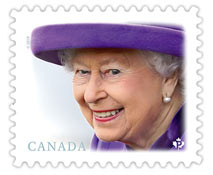Postage Stamp Design:
Commemorative Postage Stamps

Margaret Atwood 1921
Canada Post launched its commemorative stamp honouring Margaret Atwood on the week of her 82 birthday. A terrific portrait by Ruven Afanador from a shoot for Time magazine was adapted, seemingly allowing us inside Atwood's prodigious literary mind. The line "A word after a word after a word is power" is from her poem "Spelling".
I love the 1975 self-portrait "Neither fish nor flesh" used as the cachet on the official first day of issue envelope; it shows her self-deprecating humourous cartoon reflecting her love of birds.



Christopher Plummer 2021
I am proud of this tribute to the late Christopher Plummer on a commemorative stamp of my design issued by Canada Post in 2021. Plummer was consulted on and approved the final design. Ghosted in the storm cloud background are several of his many roles (Lear, Kipling, Von Trapp, Barrymore), conjured by the main figure of him as Prospero in The Tempest at Stratford in 2010. I had a hand from several remarkable illustrators (Spooky Pooka created the stormy sea and sky) and photographers (Andrew Eccles, et al).
Plummer was a one-of-a-kind actor of stage and screen, a proud Canadian, and a consummate gentleman (with a wicked sense of humour!).


Stan Rogers 2021
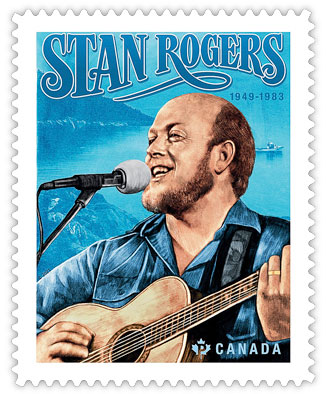
This stamp commemorates one of Canada's greatest and most beloved singer-songwriters. A great team worked to realize the design by Steven Slipp: Peter Strain illustrated Stan from a 1980s concert photo by Paul Coates that existed only in black and white. The hand-lettered wording at the top of the stamp, realized by Bonnie Ross, was inspired by the cover of Rogers' album, Between the Breaks…Live! The background is is based on a photo of Fogartys Cove by Darren Calabrese.
Issued in time for the 2021 virtual StanFest, the front of the Official First Day Cover features another Strain illustration of Rogers performing at the Dalhousie Arts Centre in Halifax in the early 1980s, based on a photograph that appeared on the cover of his posthumous release, From Coffee House to Concert Hall. The hand-lettered titles of some of Roger's best-known songs appear as waves in the background of the official first day cover envelope.

Robertson Davies 2013

Canadian novelist, playwright, critic, journalist, and professor, Davies was one of Canada's best known and most popular authors, most famous for The Deptford Trilogy. He was founding Master of Massey College at the University of Toronto.
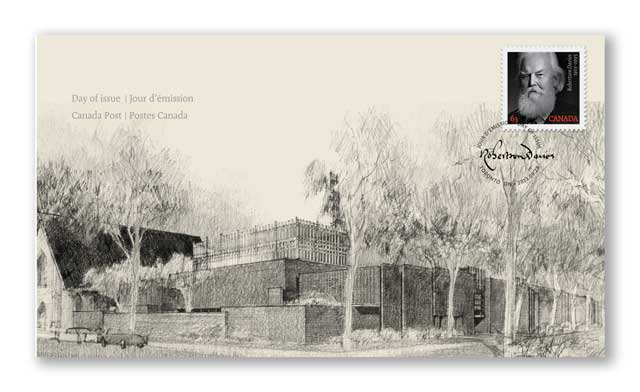
Cupids, Newfoundland: First English Settlement in Canada 2010

Created to celebrate the 400th anniversary of the founding of the community of Cupids, Newfoundland and Labrador – the first English settlement in what is now Canada. In August, 1610, English colonists led by Bristol merchant John Guy arrived at Cupids on the north side of Conception Bay on Newfoundland’s Avalon Peninsula and established an English settlement. In 1995, evidence of their colony was uncovered by a team from Baccalieu Trail Heritage Corporation led by archaeologist William Gilbert. Since then, the remains of six early 17th-century structures and more than 147,000 artefacts have been unearthed. The stamp features a portion of a 17th-century map of the Avalon Peninsula—the first map to show Cupids’ location. The coins, glass and rare amber beads on the stamp are images of the uncovered artefacts and highlight the commercial rationale for the settlement.

Korean War 2003

On June 25, 1950, war broke out when North Korea invaded
South Korea. The war was brought to an end on July 27, 1953 with the signing
of the Korea Armistice in Panmunjom, North Korea. On the 50th anniversary
of this occasion, Canada Post issued a single domestic rate stamp to recognize
and honour those who served in the Canadian army, navy and air force as part
of the UN forces. This stamp features a photojournalistic presentation of
our forces in Korea. Depicted, from left to right, are an F-86 Sabre of the
type flown by Canadian Air Force pilots, shown on an American base in Korea;
navy personnel hauling in a line while patrolling the Korean coast; and infantry
men holding the line in the hills of Central Korea.
Based on a photograph
by Bill Olson
Based on a photograph provided by Larry Milberry
Based on a
photograph by W.N. Cridland
Canadian Universities series, 2002

The first in a multi-year series featuring Canadian universities celebrating significant anniversaries.



Klondike Gold Rush Series 1996

These lively designs commemorate the 19th Century gold rush. The series design features the colourful characters who populated Dawson City and the Klondike - from Northwest Mounted Police Sergeant Sam Steele protecting a shifting border with the U.S., to Skookum Jim, the aboriginal prospector (historically denied credit for the discovery until this stamp featured him and his frog spirit).
Research for the designs utilized images from a large resource of early photography - a new and rapidly spreading technology in the 1890s and a means for prospectors to send home images of their exciting life up North.


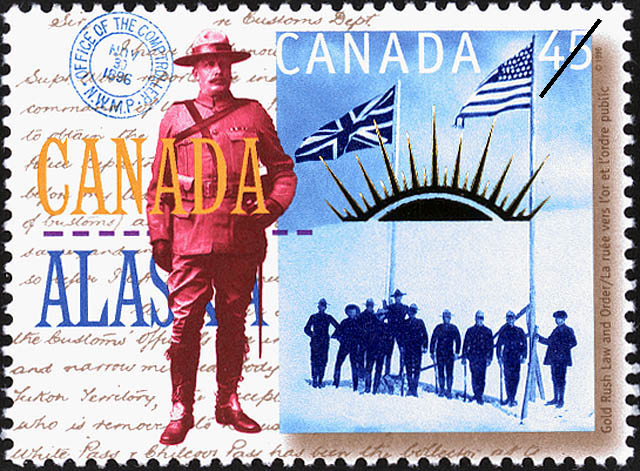

Lunenburg Academy 1995

A beacon of higher education, this school building sits high up on a hill, crowning the magnificent architectural gems in this UNESCO World Heritage town. Stamp designers Steven Slipp and Brian Mackay-Lyons found a correlation between wood-frame construction and shipbuilding in a curved roof detail, proving these were the same skilled local carpenters who also constructed the sailing vessel Bluenose.
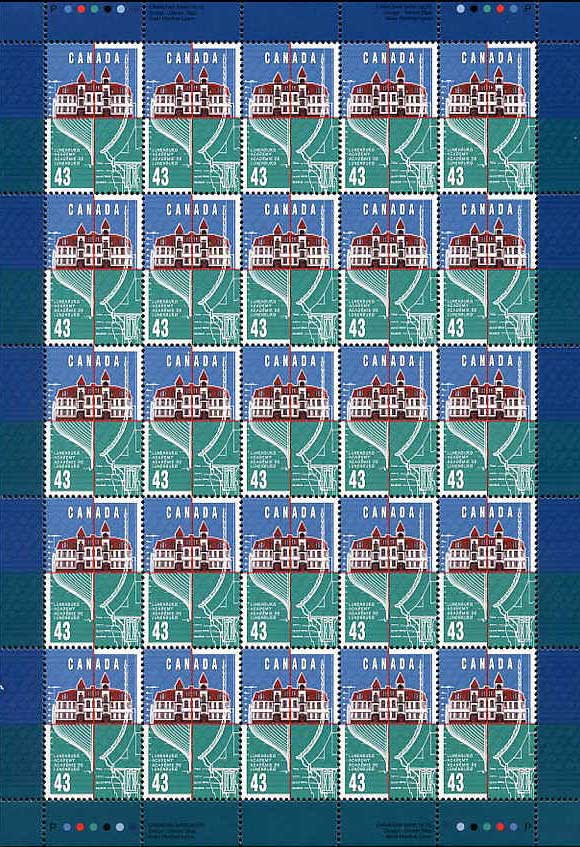
Christmas ‘Gift-bringers‘ series 1991
Children the world over know him by many different names and dressed in various garbs, but there is no doubt that our Santa Claus brings countless joy to millions during the festive Yuletide season each year. The very multicultural make-up of Canada today lends credence to the fact that the jolly old gentleman will be remembered according to one's ethnic background and upbringing. The designs are based on four characters made from torn paper collages scanned, edited and digitally reduced to the proper stamp size. Combining traditional art with the latest in technology, Slipp's ingenuity marked the first time that final artwork for a Canadian stamp was simply a computer file!

The 35¢ incentive rate stamp features Great Britain's Father Christmas. Unlike most other versions, his character evolved from pagan festivals which were held around the time of the winter solstice, which coincided with the Christian celebration of Christmas. As the old tale goes, he rode a donkey or a goat from feast to feast during the 12 days of Christmas. Wherever he visited, he left gifts for the stockings and a Yule for the hearth.

The 40¢ domestic rate stamp depicts a traditional Canadian Santa. He is our version of the European St. Nicholas, a philanthropic bishop who lived in the 4th century in what is now Turkey. This Dutch creation was transformed into a "jolly old elf" with a reindeer-drawn sleigh in such 19th century works as "The Night Before Christmas" by Clement Moore.
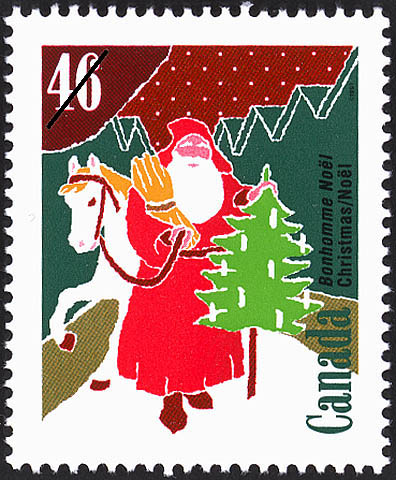
France's Bonhomme Noël is the subject of the 46¢ stamp. St. Nicholas, who eventually became Bonhomme Noël, began the gift-giving tradition in the 12th century by filling children's shoes with gifts. He was later accompanied with Père Fouettard who left whips for the naughty children.

The 80¢ international rate design shows one of the Sinterklaas "Santas" common to many European countries. Renowned for giving generously to the poor secretly at night, the day of his death, December 6, was declared an official Church holiday in the 12th century. In some countries, that day is still an occasion for exchanging gifts today.
Charles Inglis, First Anglican Bishop in Canada 1988

Charles Inglis was born in Ireland in 1734. He emigrated to the American colonies in 1754 where he worked as school master, missionary and rector. A staunch Loyalist, he fled the Colonies for England after the American Revolution. In 1787 he was consecrated Anglican Bishop of Nova Scotia to reward his loyalty and service. Inglis established an Academy at Windsor, Nova Scotia which evolved into Kings-Edgehill School and the University of King's College at Halifax. Bishop Inglis died in 1816. The stamp incorporates an illustration by Kevin Sollows in the style of a stained glass window. A church and school in the background make reference to Inglis' accomplishments in those fields.

